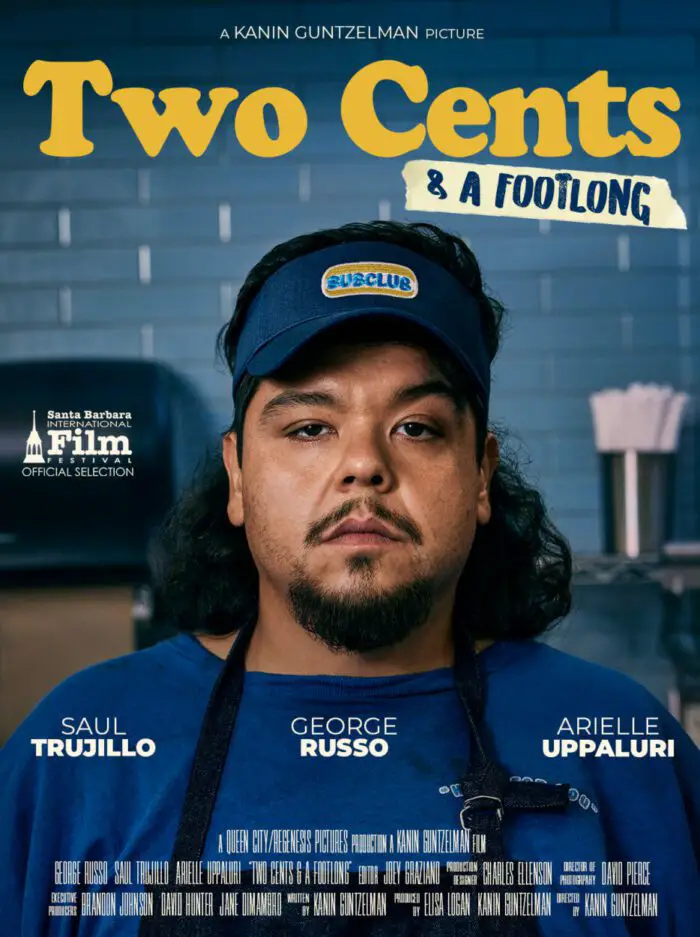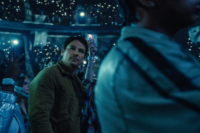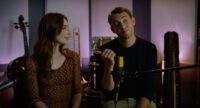“How’s it going?” is a question we’re all asked, every day, the answer typically eliciting an innocuous and often at least mildly untruthful fiction. “Fine,” we’re prompted to say, or maybe “can’t complain,” even when we can. We all know it’s not an occasion calling for an honest answer. But for Rodger, the protagonist of writer-director Kanin Guntzelman’s short film Two Cents and a Footlong, “How’s it going?” is a question just begging to be answered as honestly, as painfully as possible. The problem is that the question comes while he’s placing his order at a 24-hour sub-sandwich shop and the employee who asked him “How’s it going?” has, as you might imagine, little interest or investment in a truthful response.
Two Cents and a Footlong takes place over the course of Rodger’s sandwich order as Lenny, the tired employee, fulfills Rodger’s order and navigates his unlikely responses, ones that take the film in surprising and comical directions. Guntzelman’s film explores what happens when we violate the social contract that expects us all to ignore each other’s pain and trauma and, instead, take a few precious minutes to engage one another in a more truly empathetic—if fitfully awkward—discourse.
A lifelong Californian, Guntzelman has been making films since childhood and is today a Clio-winning commercial director and writer creating engaging branded work for global clients such as Johnson&Johnson, Aveeno, and Apple. As his Two Cents and a Footlong begins its run on the festival circuit, Guntzelman took time to speak with Film Obsessive’s J Paul Johnson on the film’s origins, production, and reception.
The transcribed interview below has been edited for space and clarity.
Film Obsessive: Welcome, Kanin. Some of our readers and listeners have seen Two Cents and a Footling, others not. Can I have you talk a little bit about what it is that occurs during this single sandwich order?
Kanin Guntzelman: Absolutely. So Two Cents and A Footlong is essentially about a gentleman who goes into a 24-hour sub shop to get some food at about four in the morning. Just as he’s about to order the employee asks him “How’s it going?” Which then forces the customer to assess every decision he’s ever made in his entire life as a sandwich is being prepped for him. This causes basically a reflection with that character, as he examines choices that he’s not proud to explore—wishing maybe he had lived a different life. And in that moment, he’s desperately needing to find some connection and the employee just happened to be the target closest to him. And the story is about that process and what ends up happening as a result of that.
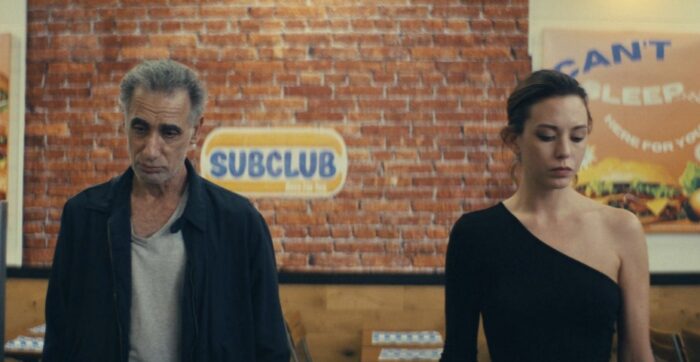
The performances are really full of those awkward and uncomfortable moments in polite dialogue where we know we’re supposed to say something polite and appropriate. And your protagonist, Rodger, is rejecting that, really searching for something more authentic and honest, even if it’s pretty painful.
Exactly. And that’s the thing, the inspiration for the whole film happened from a real situation that I was in where years ago I was really kind of down and out. Things weren’t working out. I was in a really rough spot and I ended up going to a Subway at four in the morning to eat my feelings. And as I walked in there, you know, I was coming from a bar and my mind was racing all over the place. And I walked in there just just spinning about a couple decisions I had made in the weeks prior and all these things. And this employee looks at me and just goes, “Hey man, how’s it going?”
As he said it to me, my mind just exploded because I was just sitting there going, do I tell this guy how my life is a crashing zeppelin? Do I tell this guy how I think my best years are behind me and I basically am now living a life which I will only regret? Do I unload on this person? And in the moment I caught myself and I was like, no, I’m going to choke this down. This isn’t for him. It’s my business, my weight. And I went about my business, but the interaction never left me.
I thought about it a lot because, you know, in that time I was so full of pain and uncertainty that I wished I had said something, and who knows what would have happened? But then, you know, years later, I was compelled to sit down and explore the concept of what if I had taken the step and said something, then?
What if you had told the truth? And your character, Rodger, does tell the truth. I saw in your press materials that it was kind of his Howard Beale moment, so to speak.
Yes, exactly. So one of the big instigating factors in me sitting down to write this was after I had watched Network and of course, the famous Howard Beale freakout on live television in that situation. Of course, it’s on a ten, it’s going viral for the ’70s. It was definitely going to be a more intimate situation in my film. But I was so inspired about just the idea of I’m going to tell the truth. No matter what the consequences are in this moment, I will be 100% honest. And even if the situation did not call for that in any way, shape or form. And so like it was that feeling and that someone bearing their soul that I wanted to have in more intimate setting, obviously at a sub shop, but at the same time.
I’m not going to say it’s just as impactful as Network—obviously that’s a classic. But I’m saying it’s just as significant because more than ever, when you’re in an interaction with an employee or you go to Target, I feel like everyone knows the script, everyone knows. We’re going to have the quick, quiet pleasantries. We’re not going to hold this up. We’re not going to really challenge each other’s opinions. We’re not going to reveal too much because that is uncomfortable. It’s awkward. It’s this or that. In the middle of this dance that we’ve all done 1,000 times every single day. No, no, no, no, no. I’m going to break this dance and I’m just going to share my heart right now. And I thought that was just an interesting premise for a short film.
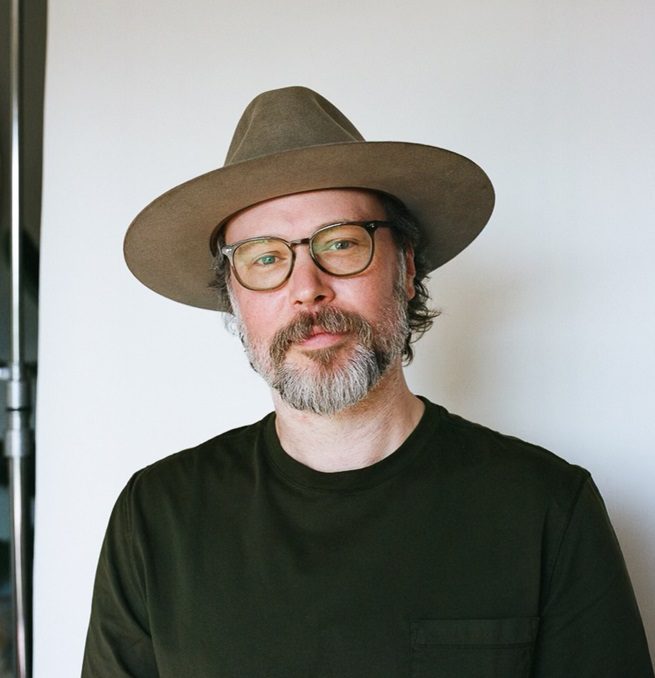
It is! And I like the conceit of the construction of the sandwich because it necessarily propels the plot along because the sandwich has to get made to satisfy the order. But it also slows it down so the conversation can keep occurring. It’s also a horrendous looking sandwich! By the time Rodger has done agreeing to almost every ingredient imaginable, with all the ingredients, all the toppings, three different completely incompatible sauces, there’s got to be some gastrointestinal consequences.
One hundred percent, yeah. And it’s funny because just as you say it, it’s like, you know, the sandwich ends up being a metaphor for his life where he’s just kind of going through picking at random. In the end, these were not the correct decisions. Like maybe if you would have put a little more thought, a little bit more analysis into these decisions leading up to how they would all worked out. It might be different, but yes, not a good sandwich at all.
Your two main characters are cast so well: George Russo as Rodger and Saul Trujillo as Lenny. How did you come to them for these particular roles? Did you have them in mind all along?
So with Rodger, I wrote it for George Russo who is a very close friend of mine and just a extraordinary actor. We’ve worked together on and off for more than a decade, in a couple other projects, and always stayed close. And he’s been in theater, he’s been in television shows, commercial, the whole nine yards, and he’s a lifetime Actors Studio member. And he was actually in the first short film I ever made, a decade ago. And from that moment, when I didn’t even know what I was doing and he trusted me to take a risk with his time and his skill set, he was such an incredible pro, but also has this wonderful blend of tragedy and comedy with ferocious comedic timing and delivery. So I wrote it for him and I and luckily enough, he agreed to do it.
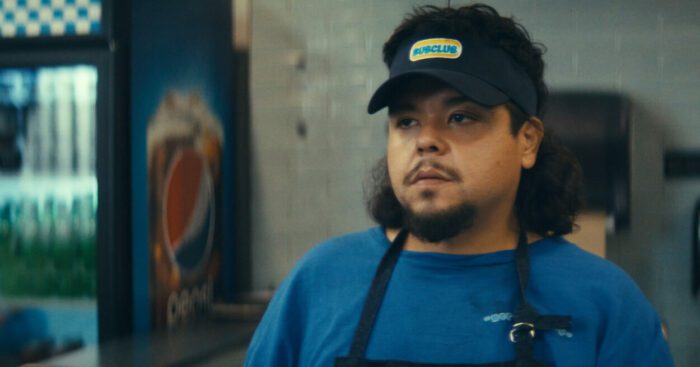
And then Saul [Trujillo]. My sister is a stand-up comedian. And I knew I wanted for the employee someone with some comedy chops. I wanted someone who could identify with the situation and root themselves in the dramatic aspects as well. I talked to her about her stand-up comedian friends and network. She read the script and as I described what I was going for, she immediately was like, oh, I got the guy, and she sent me his (Saul Trujillo’s) head shot. I looked him up and started watching live performances, and coincidentally, the first thing he was talking about in the comedy bit that I watched was his history of working nightmare situations at service jobs. He responded to the script and agreed to be a part of it, which I’m very grateful for.
Two Cents and a Footlong is about an 11-, maybe a 12-minute film, shot all in a single location with just a brief glimpse of the exterior. Could you talk a little bit about the challenges of doing that in what I assume is not only a restricted setting, but also a restricted time, with restrictions of budget, props, materials, all of that coming into play?
Exactly. The whole film was shot in one night, and it was shot at an actual sandwich chain shop just outside of L.A. Charles Ellenson, who was the production designer, and his team transformed the entire place in a matter of hours. All the branding, all the signage, all the tablescapes and everything else like that, the sandwich paper wrappers to the cups. It was a total overhaul and flip. And they just did phenomenal work and the cast and crew collectively, cinematographer David Pierce, allowed us to move at a very fast pace, because as I’m sure you saw, the film is really more so like a play.
And the whole idea behind the feeling of it was exactly what you said before, which is you walk into a sandwich shop, you’ve agreed that a sandwich is going to be made. And so it’s almost like that claustrophobic situation of like, it doesn’t matter how weird this conversation gets or if someone gets offended or whatever, we’ve agreed we’re going to stay until the sandwich is made and wrapped. So I wanted it to feel like that. And all in all, we wrapped and were leaving the place just as the sun was rising. Obviously there were some stressful points, and you try to get everything done and you’re moving so quickly. But everyone was truly professional and had a sense of urgency which allowed us to get everything we needed to do done.
Some of what George Russo says as Rodger is so inappropriate, bringing topics like masturbation and pornography into a sandwich order that they struck me almost as they could have been improvised. But I’m assuming they weren’t.
So it’s funny, they were not improvised. Those were put in the original material by myself. It was one of those things where I kept going back through my head again and again and when I was writing it of just being like, okay, I know where I want this to go. But realistically, how do we get there? How do we get two people who never have known each other, who are in a weird situation to sort of bond in some way or try to drop the gates in some way. And part of me came to the conclusion that there had to be a little bit of like a shock-and-awe effect. There had to be something where the employee at the start is so in the routine of here’s another terrible customer. I don’t care about this guy, I just want to get the sandwich made now, and then from there he’s on his heels for a moment that allows some sort of forced like relatability because just by the fact of Rodger forcing Lenny to acknowledge that, yes, he might also masturbate—boom! That’s one thing in common if there’s nothing else in the entire world. So I felt that weird out-of-the-box thing was an interesting way to enter the realm of them finding a bond.
It does! And I’ll just add to, for our viewers, there’s a moment really towards the end of the film where we really do see that this is an arc for both of these characters. That even though it’s a short incidental interaction in a subway shop, it does have an opportunity to impact each of their lives as they move forward after this narrative is concluded.
The goal was just that. It wasn’t to try to have them have some full circle transformation, but the goal was that these two ships passing in the night had some significance there. At the end of this interaction, they’re both going to leave with something. How they apply what they’ve felt or what they’ve learned from this is up to them, but that there has been something significant enough that they will not forget it. And that was the target I was aiming at.
Your career arc is one that’s involved advertising, directing commercials. Where do you see Two Cents and a Footlong fitting in, in the long term for you?
Great question. My first love of getting into this from the very beginning was to make films. I happened to stumble into advertising and directing commercials and that’s all really fun and great, and it’s great to exercise those muscles with crews, with deadlines, trying to execute creative visions and interesting sequences and shots and things. But there is something very, very different about setting out to do a film that truly means something to you. That is an existentially fulfilling work. For me, Two Cents and a Footlong is the first step in a road towards making feature films, extended television series, or things like that. My hope and dream is that that is around the corner.
In the meantime, I’m in the development of a couple of different feature films, a couple additional short films, so there’s a lot of things percolating right now. But really, what is so cool about Two Cents and a Footlong for me is that it was the first time I had returned to the narrative world in quite some time. The commercials, it’s like one of those things where you wake up and four years have gone by and you’re just always moving and you’re busy. But I had this continuous urge that was telling me, If you want to make films, you’ve got to make films. What are you doing? So I followed that voice and that’s what Two Cents and a Footlong was for me.
I know it showed at Santa Barbara International Film Festival. Were you able to be there when it showed and gauge audience reaction a little bit or interact with viewers?
So I was there, they screened it twice. And I was there for both screenings. And I was lucky enough to have my fiancée and my family and friends and other colleagues who worked on the film come up in the cast, came up and did a Q&A. And I have to tell you, it was truly a thrilling experience because it is actually the first film festival I’ve ever been to. So that shows you how ridiculous this whole situation is, because [doing] commercials you’re so busy. And so we got into Santa Barbara, which is just an extraordinary film festival for anyone who hasn’t been. It is awesome. They have all of State Street, from the Arlington Theater to a couple other theaters, all the way down to the whole festivals surrounded in—about maybe a quarter mile up and down. Everything is walkable. Everything is in downtown Santa Barbara.
Everyone is excited about the festival: excited about the films, excited about meeting filmmakers. It was a dream. It was just so fun to collaborate and to meet other filmmakers who are so passionate. And that’s a long winded way of answering your question, which is, yes, actually, I was so nervous for the first screening because we went into the theater. And I had never seen my work in a theater because I see commercials. Now they’re on phones, you know. It’s almost like foreign to me. So I’m so I’m in there and I’m just sweating bullets. I’m rocking back and forth in my seat. And then they play them in slates of like five short films together. The other short films were all extraordinary. They were all really, really good. And it was really cool to be in their company.
When I, when they finally played Two Cents and a Footlong I was like spider senses on a ten. I’m [processing] every noise, every movement, every gesture. And it was awesome. People were laughing. You could tell people were moved at certain points. And the applause, the reception, when the film was over, was just really cool. Of course I’m biased, but it seemed like people really, really enjoyed it in both screenings and came up to me afterwards and saying what the impact that the film had on them. They were very complimentary. It was a very cool experience.
I’m not surprised to hear it at all. I haven’t been to Santa Barbara specifically, but I know the very best film festivals really can do that. It certainly doesn’t surprise me to hear how audiences are reacting to the film. Do you have other festivals lined up for it in the future?
So yes, we were accepted to Mammoth Film Festival, and then more recently, Beverly Hills Film Festival. The film is going to screen in LA at the Chinese Six at 1:30 P.M. on Wednesday, May 1 (ed. note: click this link for tickets.)
That’s excellent! Thank you for joining us, Kanin, and I wish everybody involved the very best for the future success of Two Cents and a Footlong. And then I also wanted to give you the last word: anything else you’d like to say about what you hope viewers will take from the film?
Well, first and foremost, thank you so much for taking the time. It’s just so cool to be able to speak with someone who loves film like you do, and your questions are awesome: making me reflect on the whole process, which is so cool. All I ever wanted to do was have something that resonated in an honest way about feelings inside that maybe as we’re going through life and it’s fast paced and you feel like sometimes you want to connect with someone, maybe you hold back. You don’t say what’s on your mind or in your heart. And what would life be like if you did, and you found that way to do that. That’s the underlying premise, the whole thing for me, I just hope that the story resonates and it makes people feel something at the end of the day. That is the goal.
I’m sure it will. Kanin. Thank you again for speaking with us.
Of course. Thank you so much.
